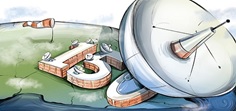08 December, 2025
Bharat Forecast System (BFS)
Mon 26 May, 2025
Reference:
- On 26 May 2025, the Ministry of Earth Sciences, Government of India, launched a high-resolution (6 km) numerical global weather model named Bharat Forecasting System (BFS).
Key Highlights:
- Launched by Union Minister of Earth Sciences, Dr. Jitendra Singh at Vigyan Bhawan, New Delhi.
- Developed by Indian Institute of Tropical Meteorology (IITM), Pune.
- Built with a 6 km high-resolution grid, making it one of the most accurate global weather forecast models.
- Aims to deliver hyper-local weather forecasts up to the panchayat level, helping sectors like agriculture, disaster management, water resources, and public health.
Main Features:
High Resolution (6 km):
- BFS operates on a 6 km grid resolution, which is twice as precise as the previous global forecast models (12 km grids).
- It enables micro-level weather predictions, crucial for forecasting localized extreme events like cloudbursts.
Panchayat-Level Forecasting:
- Provides localized forecasts at the panchayat level, benefitting rural communities, especially farmers.
- It is a joint initiative of the Ministry of Panchayati Raj, India Meteorological Department (IMD), and Ministry of Earth Sciences.
Nowcasting (2-hour Forecast):
- Offers nowcasting for the next 2 hours to predict short-term, fast-changing weather events such as thunderstorms and cloudbursts.
- Utilizes data from 40 Doppler Weather Radars, with a plan to expand to 100 radars.
Supercomputer 'Arka':
- Powered by the ‘Arka’ supercomputer with 11.77 petaflops of computational speed and 33 petabytes of storage.
- Processes data faster than the previous ‘Pratyush’ system, reducing forecast time from 10 to 4 hours.
Disaster Management and Other Benefits:
- Accurate predictions of cyclones, heavy rainfall, heatwaves, and other extreme weather events.
- Helps in disaster risk reduction, agricultural planning, water management, and public safety.
Analysis:
1. Technological Advancement & Self-Reliance:
- BFS is India’s first indigenous high-resolution weather model, reducing dependency on global models like the US GFS or CFS.
- Its fine resolution improves accuracy in predicting micro-events like cloudbursts.
- Backed by the high computing capacity of 'Arka', it ensures faster and more reliable forecasts.
2. Impact at Panchayat Level:
- Helps farmers make informed decisions regarding sowing, irrigation, and harvesting.
- Supports food security and agricultural productivity.
- Weather updates will be integrated with digital platforms like e-GramSwaraj and Meri Panchayat app.
3. Disaster Management:
- Enhances early warning systems for extreme weather events.
- The 2-hour nowcast improves real-time administrative responses to disasters.
4. Economic and Social Impact:
- Helps reduce economic losses by guiding timely agricultural and public safety actions.
- Improves community resilience through localized alerts.
- Supports efficient water resource and flood management.
5. Global Positioning:
- With its 6 km resolution, BFS is one of the most advanced global weather models.
- Establishes India as a technological leader in meteorology.
- Enhances India's global scientific reputation.
Ministry of Earth Sciences (MoES):
- Established in July 2006 by upgrading the Department of Ocean Development.
Key Functions and Responsibilities:
- Weather and climate forecasting through IMD (monsoons, cyclones, heatwaves).
- Earthquake and tsunami monitoring via the National Tsunami Warning Center.
- Ocean and coastal monitoring for marine resource prediction.
- Earth observation using satellites and radar.
- Promoting scientific research through dedicated institutions.
Major Organizations under MoES:
| Organization Name | Year of Establishment | Headquarters Key | Role/Functions |
| India Meteorological Department (IMD) | 1875 | New Delhi | Weather & climate forecasts, cyclone warnings, monsoon monitoring, BFS-based panchayat forecasts |
| Indian Institute of Tropical Meteorology (IITM) | 1962 | Pune, Maharashtra | Monsoon research, climate modeling, BFS development, operates supercomputer 'Arka' |
| National Center for Seismology (NCS) | 2006 | New Delhi | Seismic monitoring, earthquake risk assessment, early warning, updated seismic hazard maps |
| National Institute of Oceanography (NIO) | 1966 | Dona Paula, Goa | Marine biodiversity, resource exploration, blue economy, deep-sea mining research |
| National Centre for Polar and Ocean Research (NCPOR) | 1998 | Vasco-da-Gama, Goa | Manages Antarctic stations (Maitri, Bharati), polar climate studies, marine research |


















